Grace Robert. Advanced Blowout and Well Control
Подождите немного. Документ загружается.

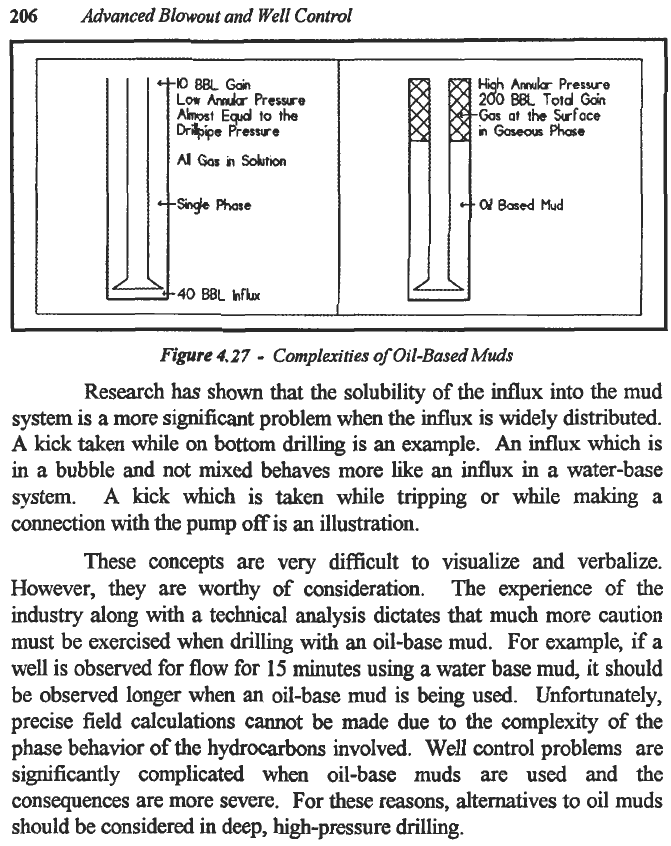
206
Advanced Blowout and Well Control
H
h
Amla
Preswe
280
BBL
Toid
Gain
Gas
at
!he
%face
nGaseousPhase
Od
Baaed
Mud
~~
Figure
4.2
7
-
Complexities
of
Oil-Based
Muds
Research
has
shown that the solubility of the influx into the mud
system is a more significant problem when the influx is widely distributed.
A
kick taken while on bottom drilling
is
an example.
An
influx which is
in
a
bubble and not mixed behaves more like
an
influx in
a
water-base
system.
A
kick which is taken while tripping or while making a
connection with the pump
off
is
an
illustration.
These concepts are very difficult
to
visualize and verbalize.
However, they are worthy of consideration. The experience of the
industry along with
a
technical analysis dictates
that
much more caution
must be exercised when drilling with
an
oil-base mud. For example, if a
well is observed for
flow
for
15
minutes using
a
water base mud, it should
be observed longer when an oil-base mud is
being
used. Unfortunately,
precise field calculations cannot
be
made due
to
the complexity of the
phase behavior of the hydrocarbons involved. Well control problems are
significantly complicated when oil-base muds are used and the
consequences are more severe. For these reasons, alternatives to oil muds
should be considered in deep, high-pressure drilling.
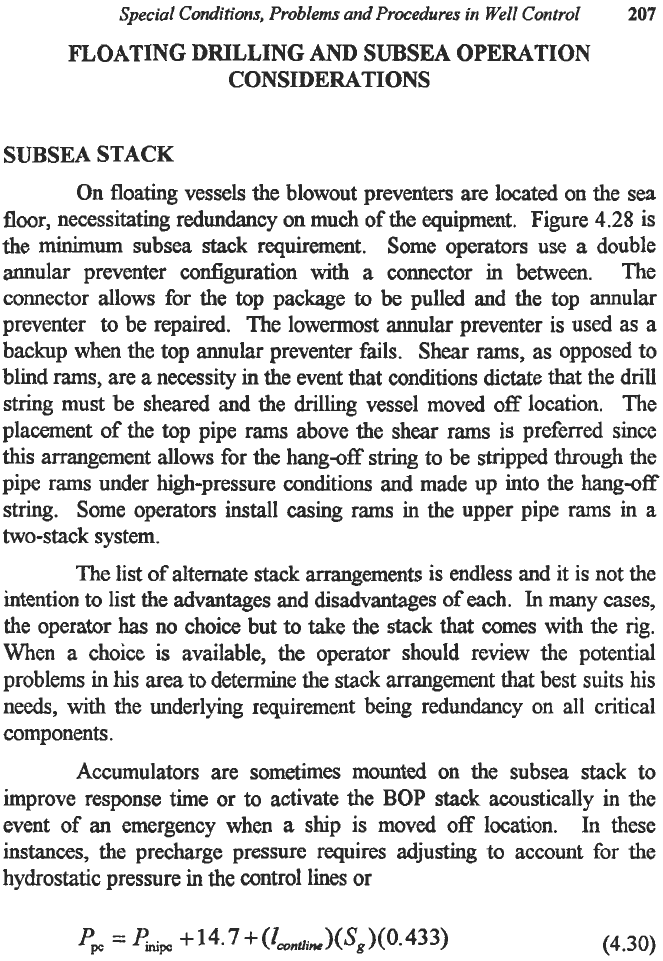
Special Conditions, Problems and Procedures
in
Well
Control
207
FLOATING DRILLING AND SUBSEA OPERATION
CONSIDERATIONS
SUBSEA STACK
On floating vessels the blowout preventers are located on the sea
floor, necessitating redundancy on much of the equipment. Figure
4.28
is
the minimum subsea stack requirement.
Some operators use
a
double
annular preventer configuration with
a
connector in between. The
connector allows for the top package
to
be pulled and the top annular
preventer to be repaired. The lowermost annular preventer is used as a
backup when the top annular preventer fails. Shear
rams,
as opposed to
blind
rams,
are
a
necessity
in
the event that conditions dictate that the
drill
string must be sheared and the drilling vessel moved
off
location. The
placement of the top pipe rams above the shear
rams
is
preferred since
this
arrangement allows for the hang+ff string to be stripped through the
pipe rams under high-pressure conditions
and
made up into the
hang-off
string. Some operators install casing rams
in
the upper pipe
rams
in a
two-stack system.
The list of alternate stack arrangements is endless and it is not the
intention
to
list the advantages and disadvantages of each.
In
many
cases,
the operator
has
no choice but
to
take
the stack
that
comes with the rig.
When a choice is available, the operator should review the potential
problems in
his
area to determine the stack arrangement that best suits his
needs,
with
the underlying requirement being redundancy
on
all critical
components.
Accumulators are sometimes mounted on the subsea stack to
improve response time or
to
activate the
BOP
stack
acoustically in the
event of an emergency when
a
ship is moved off location.
In
these
instances, the precharge pressure requires adjusting to account for the
hydrostatic pressure
in
the control lines or
Ppc
=
P~pc
+14.7+(Zm,,,i,)(Sg)(0.433)
(4.30)
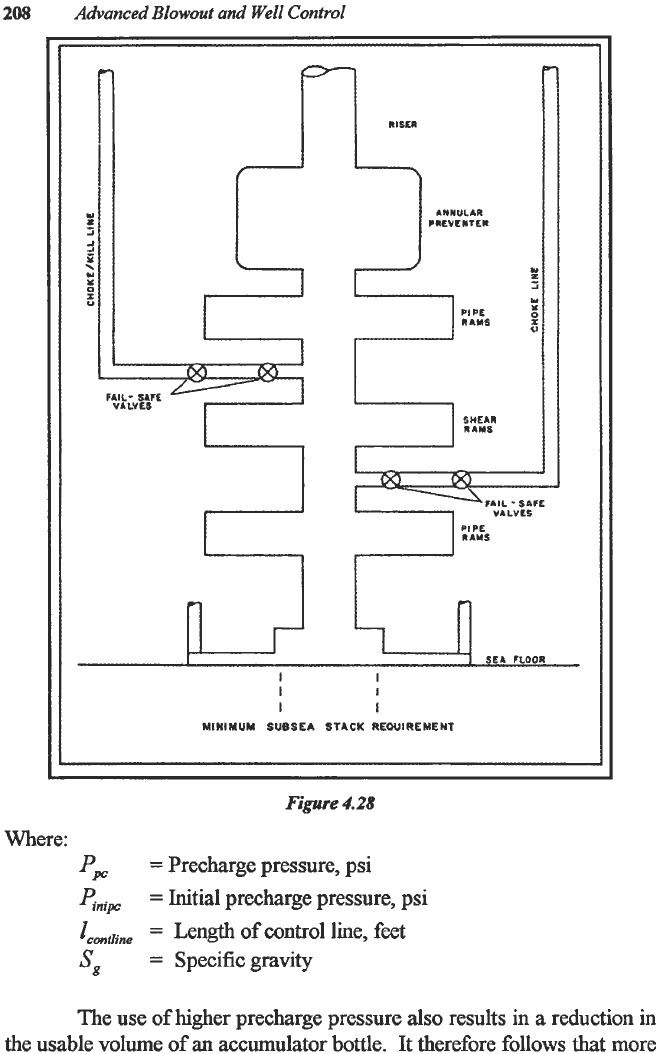
20s
Advanced
Blowout
and
Well
Control
i4lL-
SAFE
VALVES
rl
L
n
I
I
I I
MINIMUM SUBSEA
STACK
REOUIREMENT
I
Figure
4.28
PF
=
Precharge pressure, psi
=
Initial precharge pressure, psi
Zcmtljne
=
Length
of control line,
feet
SL?
=
Specific gravity
Where:
The use of higher precharge pressure
also
results in a reduction in
the usable volume
of
an
accumulator bottle.
It therefore follows that more
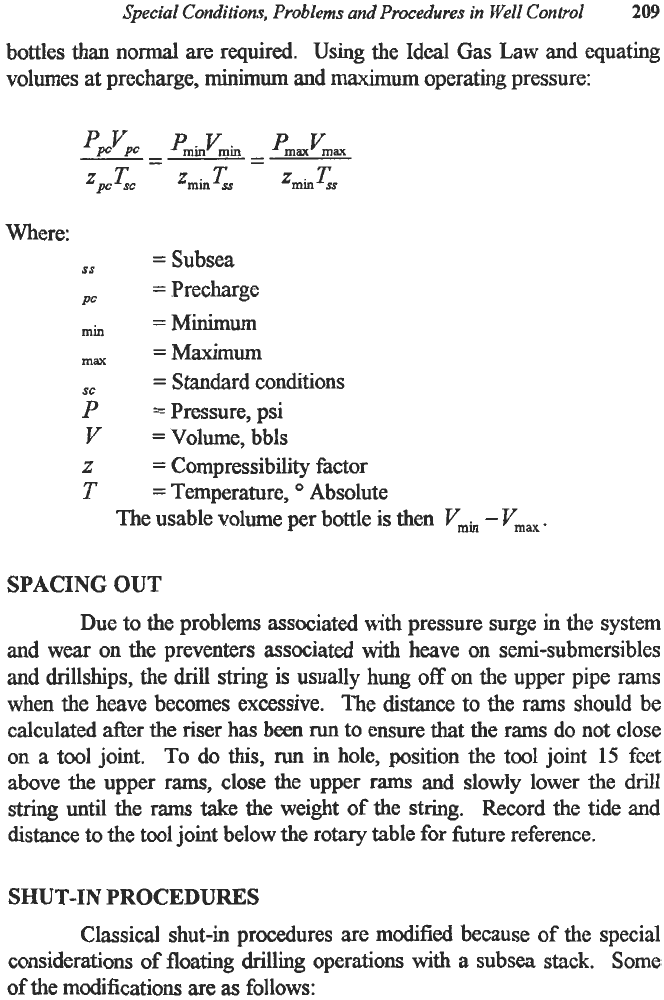
Special Conditions, Problems and Procedures
in
Vel1
Control
209
bottles than normal are required. Using the Ideal
Gas
Law and equating
volumes at precharge, minimum and maximum operating pressure:
Where:
ss
=
Subsea
=
Precharge
=
Minimum
max
=
Maximum
sc
=
Standard conditions
P
=
Pressure, psi
Y
=
Volume, bbls
Z
=
Compressibility factor
T
=
Temperature,
O
Absolute
pc
min
The usable volume per bottle is then
Ymh
-
V,,,
.
SPACING
OUT
Due to the problems associated with pressure surge in the system
and
wear
on the preventers associated
with
heave
on
semi-submersibles
and drillships, the drill string
is
usually hung
off
on
the upper pipe
rams
when the heave becomes excessive.
The distance to the rams should be
calculated after the riser has been
run
to ensure that
the
rams do not close
on a tool joint. To
do
this,
run
in hole, position the tool joint 15 fcet
above the upper rams, close the upper rams
and
slowly lower the drill
string until the rams take the weight
of
the string. Record the tide and
distance to the tool joint below the rotary table for future reference.
SHUT-IN
PROCEDURES
Classical shut-in procedures are modified because of the special
considerations of floating drilling operations with a subsea stack. Some
of
the
modifications are
as
follows:
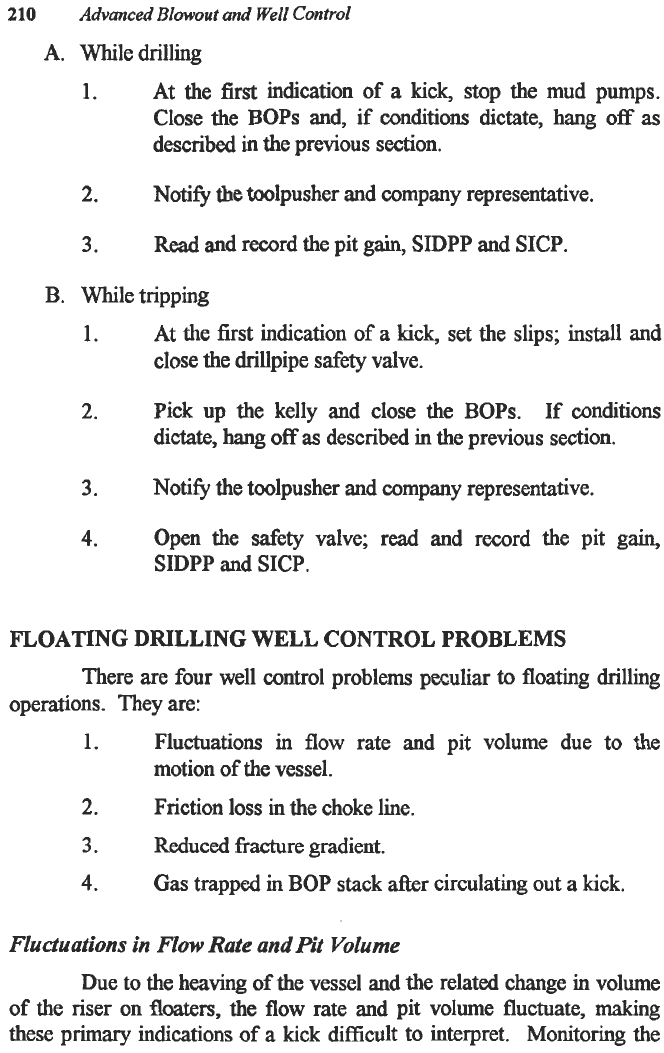
210
Advanced
Blowout
and
Well
Control
A.
Whiledrilling
1.
At the first indication of
a
kick, stop the mud pumps.
Close the BOPS and, if conditions dictate, hang
off as
described in the previous section.
2.
Notie the toolpusher and company representative.
3.
Read
and record the pit gain, SIDPP and SICP.
B. Whiletripping
1.
At the first indication
of
a kick, set the slips; install and
close the drillpipe
safety
valve.
2.
Pick up the kelly and close the BOPS.
dictate, hang
off
as
described in the previous section.
If conditions
3.
Notify the toolpusher and company representative.
4.
Open the safety valve; read and record the pit gain,
SIDPP and SICP.
FLOATING DRILLING WELL CONTROL PROBLEMS
operations. They are:
There are
four
well control problems peculiar
to
floating drilling
1.
Fluctuations in flow rate and pit volume due to the
motion of the vessel.
2.
Friction loss in the choke line.
3.
Reduced
fracture
gradient.
4.
Gas trapped in BOP stack after circulating out
a
kick.
Fluctuations
in
Flow Rate and
Pit
Volume
Due to the heaving
of
the vessel and the related change in volume
of the riser on
floaters,
the flow rate and pit volume fluctuate, making
these primary indications
of
a kick difficult
to
interpret. Monitoring the
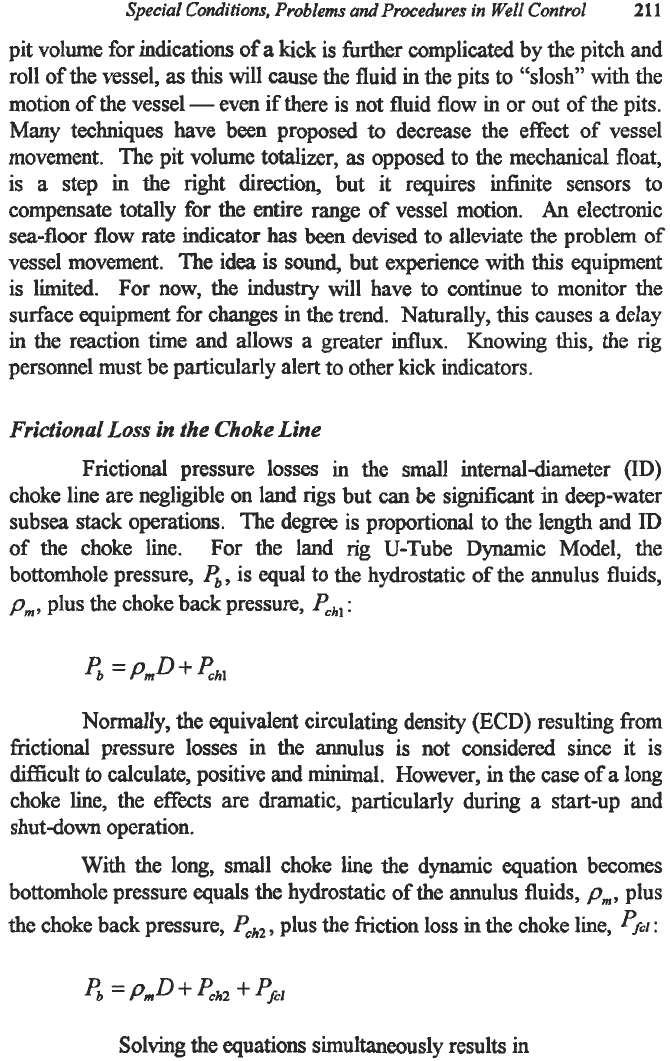
Special Conditions, Problems and Procedures in Well Control
211
pit volume for indications
of
a
kick is firther complicated by the pitch and
roll of the vessel,
as
this
will cause the fluid in the pits to
“slosh”
with the
motion of the vessel
-
even if there is not fluid flow in or out
of
the pits.
Many techniques have been proposed
to
decrease the effect of vessel
movement. The pit volume totalizer,
as
opposed to the mechanical float,
is a step
in
the right direction, but it requires infinite sensors to
compensate totally for the entire range of vessel motion.
An
electronic
sea-floor flow rate indicator
has
been
devised to alleviate the problem
of
vessel movement. The idea is
sound,
but experience with
this
equipment
is limited. For now, the industry will have to continue to monitor the
surface equipment for changes in the trend. Naturally,
this
causes
a
delay
in the reaction time and allows a greater
influx.
Knowing this, the
rig
personnel must be particularly alert to other kick indicators.
Frictional
Loss
in the
Choke
Line
Frictional pressure losses
in
the
small
internaldiameter
(ID)
choke line are negligible on land rigs but can
be
significant
in
deep-water
subsea stack operations. The degree is proportional to the length
and
ID
of the choke line. For the land
rig
U-Tube Dynamic Model, the
bottomhole pressure,
pb
,
is equal to the hydrostatic of the annulus fluids,
p,,
plus the choke back pressure,
Pchl
:
Normally, the equivalent circulating density (ECD) resulting
from
frictional pressure losses
in
the annulus is not considered since it is
difficult
to
calculate, positive and
minimal.
However,
in
the case
of
a
long
choke line, the effects are dramatic, particularly during a start-up
and
shutdown operation.
With the long,
small
choke line the dynamic equation becomes
bottomhole pressure equals the hydrostatic of the annulus fluids,
p,,
plus
the choke back pressure,
ehz,
plus the friction loss
in
the choke he,
pfii
:
Solving
the equations simultaneously results in
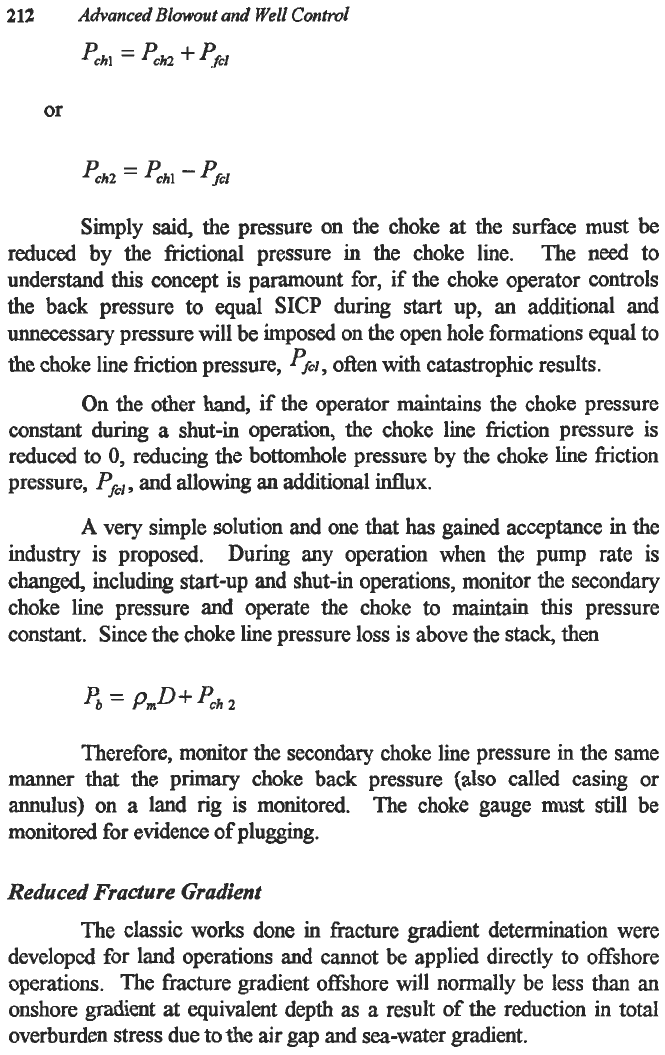
212
Advanced
Blowout
and Well
Control
ehl
=
eh2
+
'fer
or
Simply said, the pressure on the choke
at
the surface must be
reduced by the
frictional
pressure in the choke line.
The need to
understand
this
concept
is
paramount for, if the choke operator controls
the back pressure to equal
SICP
during
start
up, an additional and
unnecessary pressure will be imposed on the open hole formations equal to
the choke line friction pressure,
pfii,
often
with catastrophic results.
On the other
hand,
if the operator
maintains
the choke pressure
constant during
a
shut-in operation, the choke line friction pressure
is
reduced
to
0,
reducing the bottomhole pressure by
the
choke line friction
pressure,
Pfi,
,
and allowing an additional influx.
A
very simple solution and one
that
has
gained acceptance in the
industry is proposed. During any operation when the pump rate is
changed, includmg start-up and shut-in operations, monitor the secondary
choke line pressure and operate the choke
to
maintain
this
pressure
constant. Since the choke line pressure loss is above the stack, then
Therefore, monitor the secondary choke line pressure in the same
manner that the primary choke back pressure (also called casing or
annulus) on
a
land rig is monitored. The choke gauge must still be
monitored for evidence of plugging.
Reduced Fracture Gradient
The classic works done in fracture gradient determination were
developcd for land operations and cannot be applied directly to offshore
operations. The fracture gradient offshore will normally be less
than
an
onshore
merit
at
equivalent depth
as
a result of the reduction in
total
overburden stress due to the air gap and sea-water gradient.
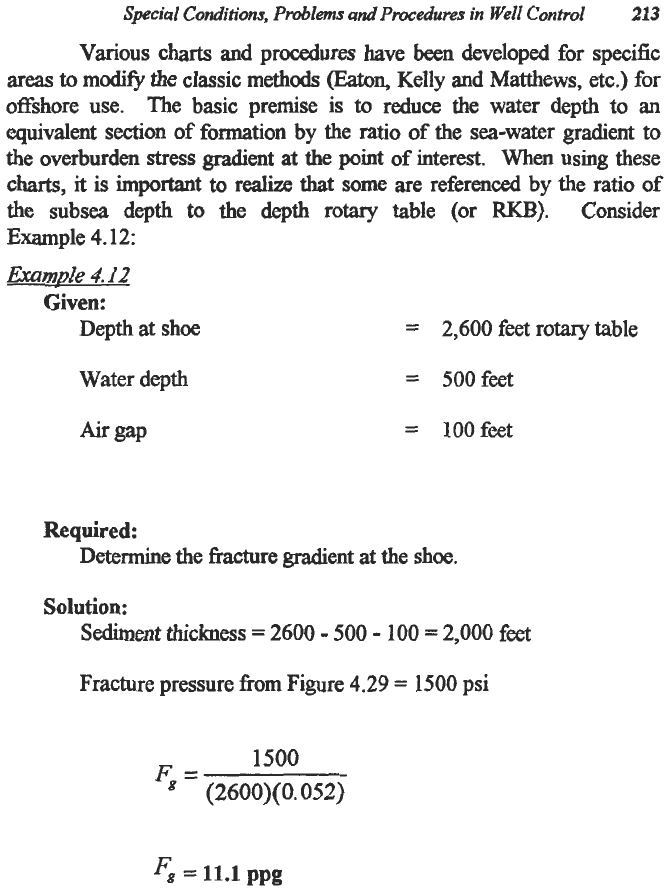
Special
Conditions,
Problems
and
Procedures
in
Well Control
213
Various
charts
and procedures have been developed for specific
areas
to
modi@ the classic
methods
(Eaton,
Kelly and Matthews, etc.) for
offshore use. The basic premise is
to
reduce the water depth to
an
equivalent section of formation by the ratio of the sea-water gradient to
the overburden stress
went
at
the
point
of interest. When using these
charts, it is important
to
realize that some
are
referenced by the ratio
of
the
subsea
depth to the depth
rotary
table (or
RKB).
Consider
Example
4.12:
Examvle
4.12
Given:
Depth at
shoe
=
2,600
feet rotary table
Water
depth
=
500feet
Air gap
=
1OOfeet
Required:
Determine the fracture gmbent at the
shoe.
Solution:
Sediment thiclmess
=
2600
-
500
-
100
=
2,000
feet
Fracture pressure from Figure
4.29
=
1500
psi
1500
Fg
=
(2600)(0.052)
F8
=
11.1
ppg
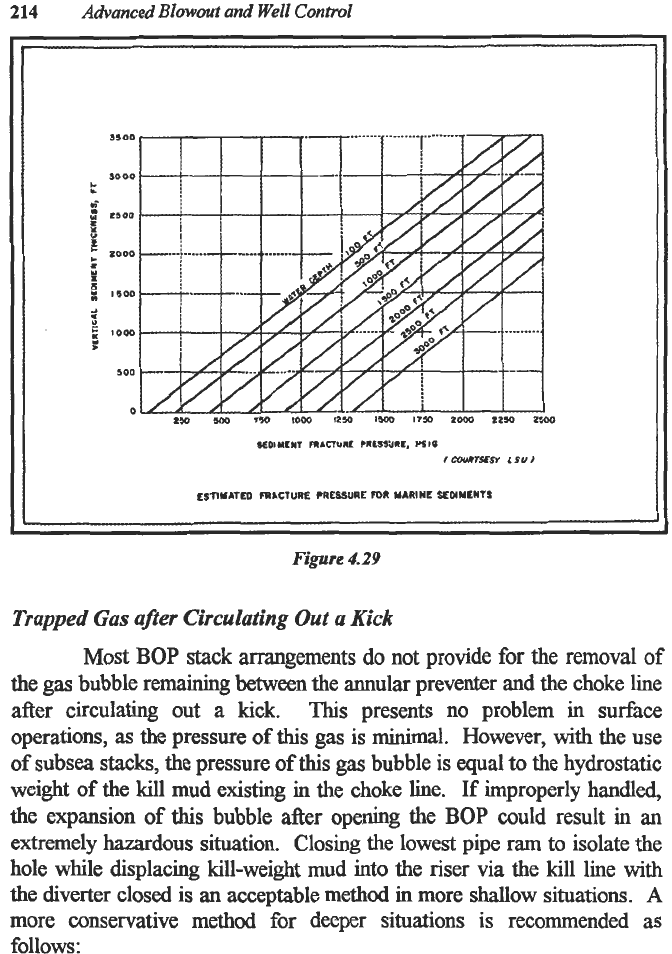
Figure
4.29
Trapped Gas aBer Circulating Out
a
Kick
Most
BOP
stack arrangements do not provide
for
the removal
of
the gas bubble remaining
between
the annular preventer and the choke line
after circulating out a kick.
This
presents no problem in surface
operations,
as
the pressure
of
this gas is minimal. However, with the use
of
subsea stacks, the pressure of
this
gas bubble is equal
to
the hydrostatic
weight
of
the kill mud existing in the choke line.
If
improperly handled,
the expansion
of
this
bubble after opening the
BOP
could result in
an
extremely hazardous situation. Closing the lowest pipe ram to isolate the
hole while displacing kill-weight mud into the riser via the kill line with
the diverter closed
is
an acceptable
method
in more shallow situations.
A
more conservative method for decper situations
is
recommended as
follows:
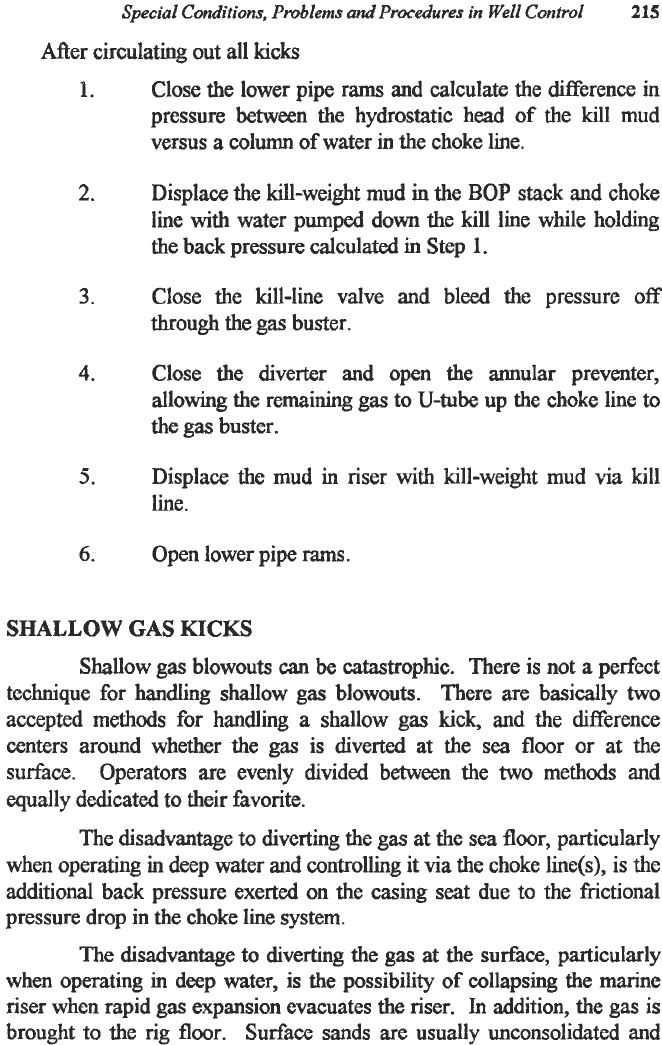
Special
Conditions.
Problems and Procedures in
Well
Control
215
After circulating out all kicks
1.
Close the lower pipe rams and CalcuIate the difference in
pressure between the hydrostatic head of the kill mud
versus a column of water in the choke line.
2.
Displace the kill-weight mud
in
the
BOP
stack and choke
line with water pumped down the kill line while holding
the back pressure calculated in Step
1.
3.
Close the kill-line valve and bleed the pressure
off
through the gas buster.
4.
Close the diverter and open the annular preventer,
allowing the remaining gas to
U-tube
up the choke line to
the gas buster.
5.
Displace the mud
in
riser with kill-weight mud
via
kill
line.
6.
Open lower pipe
rams.
SHALLOW
GAS KICKS
Shallow gas blowouts
can
be catastrophic. There is not a perfect
technique for handling shallow gas blowouts. There
are
basically two
accepted
methods
for handling
a
shallow
gas
kick, and the difference
centers around whether the gas is diverted at the
sea
floor or at the
surface. Operators are evenly divided between the
two
methods and
equally dedicated to their favorite.
The disadvantage to diverting the gas at the sea floor, particularly
when operating
in
deep water and controlling it via the choke line(s), is the
additional back pressure exerted on the casing seat due to the frictional
pressure drop in the choke line system.
The disadvantage
to
diverting the
gas
at the surface, particularly
when operating
in
deep water, is the possibility
of
collapsing the marine
riser when rapid gas expansion evacuates the riser. In addition, the gas
is
brought to the rig floor. Surface sands are usually unconsolidated and
